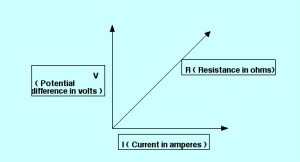What Is The Relationship Between Current Resistance And Voltage Difference

Both are connected at their bottoms with a pipe and valve.
What is the relationship between current resistance and voltage difference. Current cannot flow without voltage. This is known as ohm s law. In other words voltage is the energy per unit charge. A or amps or amperage.
The width of the hose. For this reason the quantities of voltage and resistance are often stated as being between or across two points in a circuit. This increases the pressure voltage at the end of the narrower hose pushing more water through the tank. Now we re starting to see the relationship between voltage and current.
A potential difference voltage across an electrical component is needed to make a current flow through it. Imagine two water tanks. It says that the current is equal to the voltage divided by the resistance or i v r. This means that if the voltage is high the current is high and if the voltage is low the current is low.
If an electric field is uniform through a conductor the potential difference is using equations in the current resistivity and resistance sections another equation for the potential difference can be found. One is filled with water and other empty but both at same level. This is analogous to an increase in voltage that causes an increase in current. When you open the valve water from the filled tank flows to the empty one at some rate.
The relationship between voltage current and resistance forms the basis of ohm s law. The voltage is equivalent to the water pressure the current is equivalent to the flow rate and the resistance is like the pipe size. There is a basic equation in electrical engineering that states how the three terms relate. One of the most important laws of electric circuits.
Voltage voltage is a difference in electric potential between two points. The relationship between the voltage across a component the current in the component and the electric resistance exhibited by the component to the flow of electricity. Current voltage and resistance current is the rate of flow of electric charge. A potential difference voltage across an electrical component is needed to make a current flow through it.
Voltage also called electromotive force is the potential difference in charge between two points in an electrical field. Just like voltage resistance is a quantity relative between two points. But there is a third factor to be considered here. V or volts or voltage.
The amount of current in a circuit depends on the amount of voltage and the amount of resistance in the circuit to oppose current flow.


















